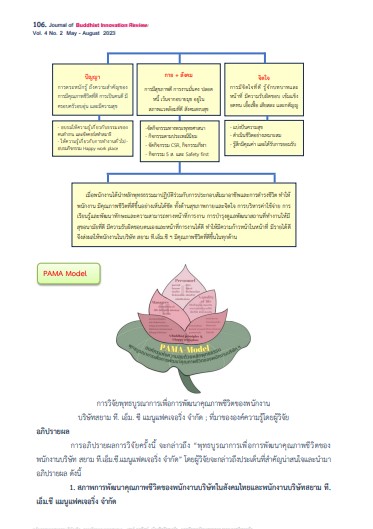A Buddhist Integration for Improve the Quality Of Life Of Employees Siam T.M.C Manufacturing Co., Ltd.
Main Article Content
Abstract
The objective of this research is (1) to study the condition for improving the employees’ quality of life in Thai society and at Siam T.M.C. Manufacturing Co., Ltd. (2) to study the Buddhist principles (Buddhadhamma) for work and for happy workplace to improve the employee’s quality of life at Siam T.M.C. Manufacturing Co., Ltd (3) to propose the integrated Buddhist principles to improve Siam T.M.C. employees’ quality of life. This research is qualitative with in-depth interviews and descriptive compilation. The research found that improving the company employees’ quality of life is important to make the employees happy at work. Applying the integrated Buddhist principles into the employees’ daily lives enables confidence in carrying out activities. In addition, it also leads to the utmost work benefits: being successful in job duties, being able to maintain oneself in discipline according to company’s disciplinary regulations. How successful it will be depending on the attention of the employees to each aspect, transparency, honesty, prudence, commitment to morality, culture and law, service with professional ethics and respect for the dignity and value of other people. Happily working for the benefit of employee development through training is an important process in transforming the employees’ behavior. The model should be briefly described.
Article Details

This work is licensed under a Creative Commons Attribution-NonCommercial-NoDerivatives 4.0 International License.
เรื่องลิขสิทธิ์/เป็นความคิดเห็นของผู้เขียน
References
หนังสือ
สำนักนายกรัฐมนตรี. แผนพัฒนาเศรษฐกิจและสังคมแห่งชาติ ฉบับที่ 12 (พ.ศ. 2560 –2564). ราชกิจจา-นุเบกษา. เล่ม 122 ตอนที่ 115 ก.
อัชฌม ชื่นบุญ และคณะ. (2562). ปัจจัยที่ส่งผลต่อความสุขในการทางานของบุคลากรในโรงพยาบาลเซนต์เมรี่. รายงานการวิจัย. (นครราชสีมา: ม.ป.ท.
พระมหาสุทิตย์ อาภากโร (อบอุ่น) และเขมณัฏฐ์ อินทรสุวรรณ. (2561). ตัวชี้วัดความสุข: กลยุทธ์การสร้างและการใช้เพื่อชุมชนเป็นสุข. กรุงเทพมหานคร.
เจษณี สุขจิรัตติกาล (แปล), (2547). ความสุขมวลรวมประชาชาติ มุ่งสู่กระบวนทัศน์ใหม่ในการพัฒนา. ศูนย์ภูฐานศึกษา (เรียบเรียง), กรุงเทพมหานคร : เฟื่อฟ้า.
วิทยานิพนธ์
พระศุภชัย คุตฺตสีโล (ฝั้นยะ). (2560). การพัฒนาองค์กรแห่งความสุขของวิทยาลัยสงฆ์ลาพูน จังหวัดลาพูน. ปริญญาพุทธศาสตรมหาบัณฑิต สาขาวิชรัฐประศาสนศาสตร์ บัณฑิตวิทยาลัย มหาวิทยาลัย-มหาจุฬาลงกรณราชวิทยาลัย.
พระวิจิตร มหาวิริโย. (2561). แนวทางการเสริมสร้างคุณภาพชีวิตเพื่อการเข้าถึงสันติสุขตามหลักมรรค ๘: กรณีศึกษาศูนย์พัฒนาศาสนาแคมป์สนจังหวัดเพชรบูรณ์. วารสารสันติศึกษาปริทรรศน์ มจร ปีที่ ๕ ฉบับพิเศษ.
นรัญญา ธนกุลภารัชต์, (2547). การศึกษาเชิงเปรียบเทียบความสุขของพุทธศาสนานิกายเถรวาทกับสุขนิยมทางจริยศาสตร์. วิทยานิพนธ์ศิลปศาสตรมหาบัณฑิต. บัณฑิตวิทยาลัย : มหาวิทยาลัยเกษตรศาสตร์.
สื่ออิเล็กทรอนิกส์
สถาบันบริหารและจิตวิทยา. (ออนไลน์) การพัฒนาทรัพยากรมนุษย์ในภาวะวิกฤต. [สืบค้นเมื่อวันที่ 12 พฤษภาคม 2560] จาก http://www.adecco.co.th.
ประชาชาติธุรกิจ. วาง ๕ แนวทางสร้างความผูกพันองค์กร [ออนไลน์]. [วันที่ 2 เมษายน 2566]. จาก https://www.prachachat.net/news_detail.php?newsid=1376470488.


